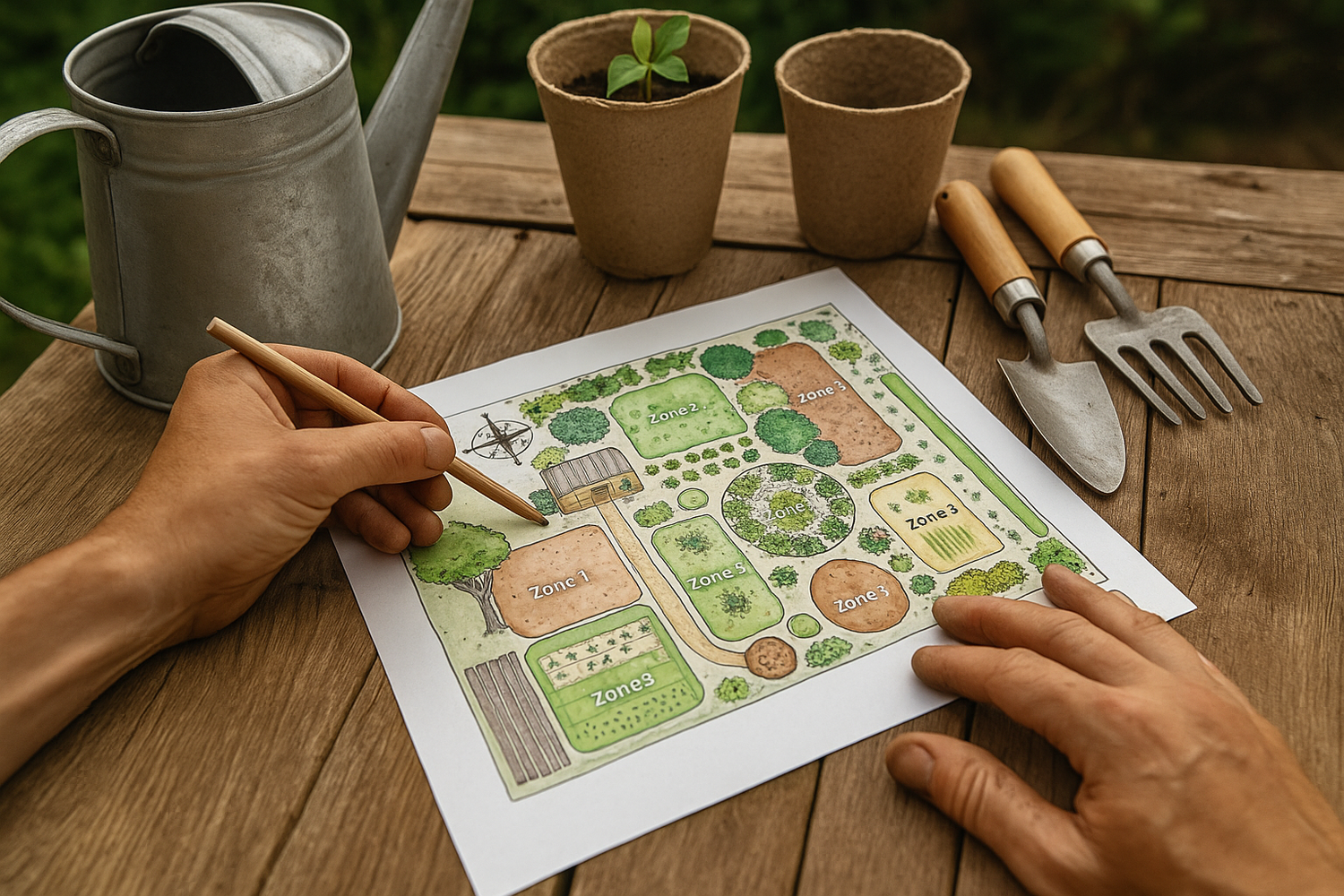Why plan your garden?
Whether you have a large plot or a small space, good planning makes all the difference. It not only optimizes your garden's productivity but also reduces fatigue, unnecessary trips, and harvest losses.
In a permaculture approach, planting is not random. You design your garden in terms of usage zones, sunlight, and functionality.
1. Understanding permaculture growing zones
In permaculture, space is divided into concentric zones ranging from the house (zone 0) outward (zone 5). Each zone corresponds to a frequency of visit:
Zone 0: the dwelling
Starting point for observation and comings and goings. Even if you don't have a farm, you can adapt it to the scale of your garden.
Zone 1: the heart of the vegetable garden
- Very frequented (daily).
- Here are placed: aromatic herbs, salads, quick-harvest vegetables, edible flowers.
- Must be easily accessible from the house door or terrace.
Zone 2: semi-intensive crops
- Visit every 2–3 days.
- Examples: tomatoes, zucchinis, beans, carrots, beets.
- Needs regular watering, but not daily.
Zone 3: low-maintenance crops
- Potatoes, cucurbits, cereals (in large gardens).
- Weekly visit.
- Mulched and as self-sufficient in water as possible.
Zone 4: semi-wild
- Orchard, fruit hedges, chicken coop, compost area, dead wood.
- Monthly to seasonal visits.
Zone 5: observation & biodiversity
- Area left “wild,” without intervention.
- Goal: welcome biodiversity, observe nature to get inspired.
👉 Even on a balcony or courtyard, this principle can be applied on a small scale. The idea is to place what needs attention close to you, and what is self-sufficient further away.
2. Take sun exposure into account
Exposure is crucial in garden organization. It determines the types of plants you can grow in each location.
How to assess exposure?
- Observe the light throughout the day, over 2–3 days.
- Use a compass or an app like “SunCalc.”
- Identify permanent shade areas, direct sunlight, and windy spots.
Orientation of plots (northern hemisphere)
- South / South-East: ideal for most vegetables (6+ hours of sunlight).
- East: perfect for heat-sensitive plants (lettuce, spinach, strawberry plants).
- North: cooler area, suitable for shade plants (sorrel, mint, ferns…).
- West: good compromise for summer crops, but watch out for the wind.
3. Organize your paths and access points
Good circulation in your garden makes daily life easier:
- Plan permanent paths with draining materials (wood chips, gravel, planks).
- Create direct access from the house to frequently visited areas.
- Think about the watering logic: avoid hoses crossing the crops.
4. Examples of inspiring plans
🌻 Small urban garden (50–100 m²)
- Zone 1: vegetable patch + herbs near the house.
- Zone 2: tomatoes + salads on mounds.
- Zone 3: potatoes, squashes on heavy mulch.
🌿 Family garden (200–400 m²)
- Zone 1: herbs, medicinal plants, quick compost.
- Zone 2: intensive cultivation on mounds + mobile greenhouses.
- Zone 3–4: orchard, fruit hedge, insect hotel, water reserve.
5. Adapt your planning over time
A garden evolves. Your uses, needs, and constraints do too. Take the time to make a plan of your garden at the start of the season, but be flexible:
- Add a logbook or a drawn plan.
- Take progress photos over the months.
- Note the successes… and the failures!
Conclusion
Planning a garden based on usage zones and sun exposure lays the foundation for a coherent, pleasant, and productive space. Whether you garden in the city or countryside, on a balcony or in open ground, this approach allows you to grow better with less.
🌱 Discover our permaculture garden kit to start with the right plants, in the right place.





Leave a comment
This site is protected by hCaptcha and the hCaptcha Privacy Policy and Terms of Service apply.